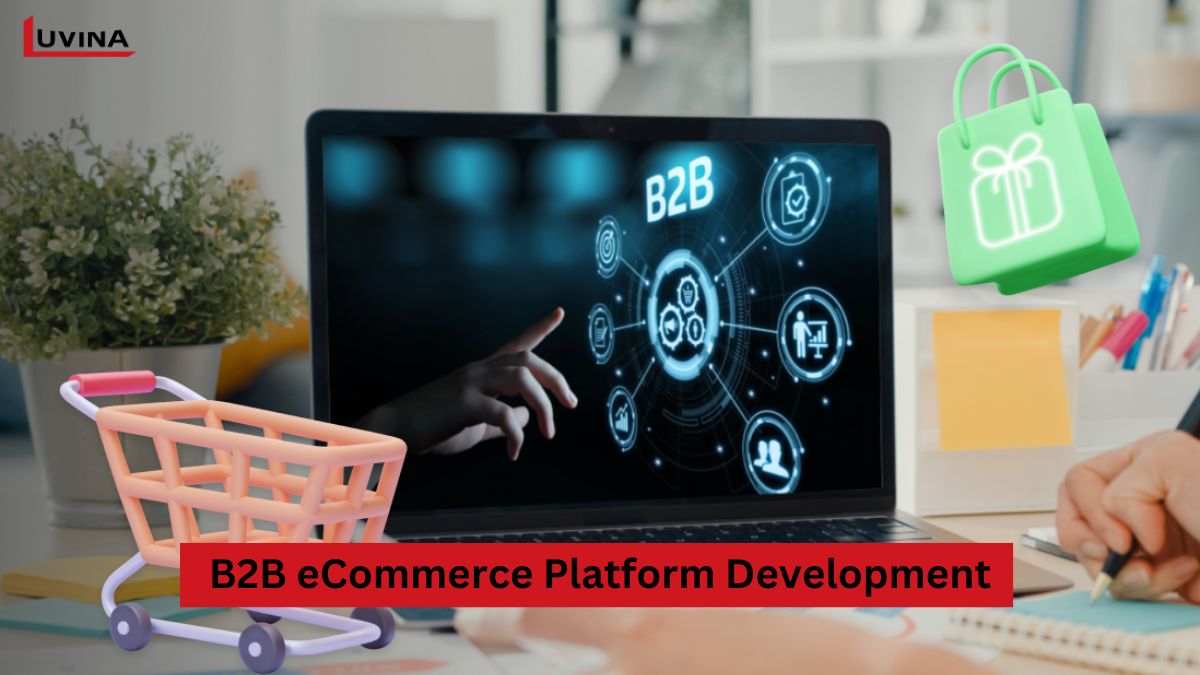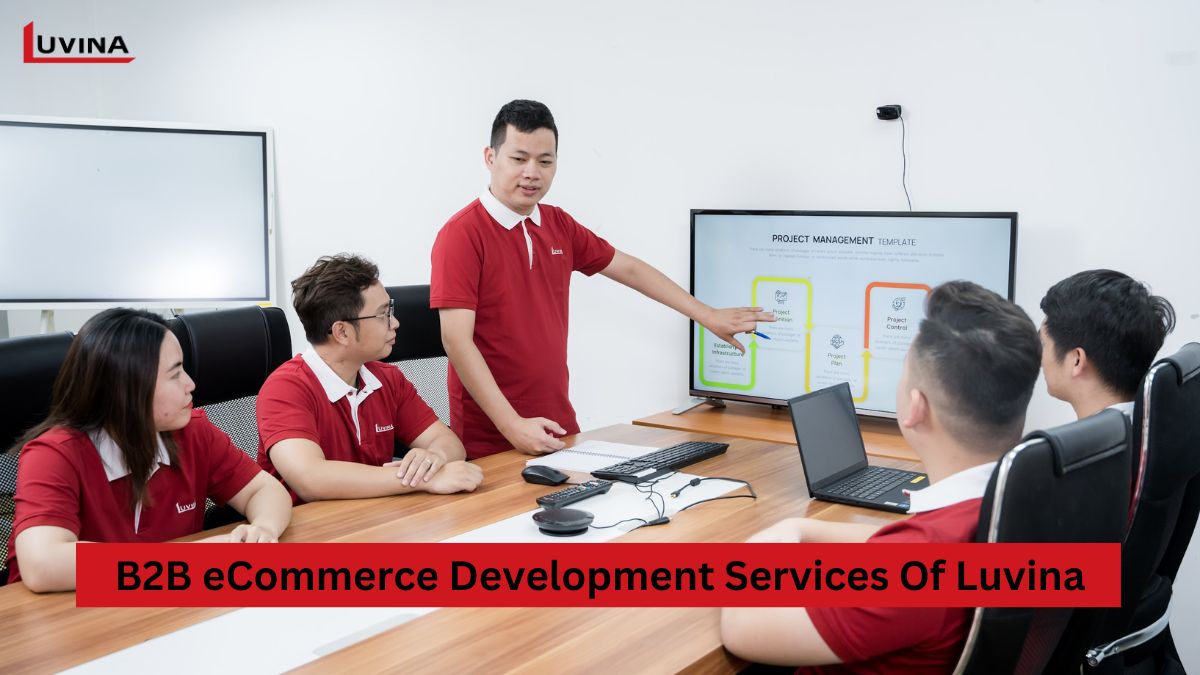With over $2.4 trillion in yearly B2B ecommerce transactions and projected growth beyond $3 billion by 2027, investing in a custom-built platform is no longer optional; it’s a strategic necessity.
This guide walks you through what modern B2B ecommerce means, the essential features your business needs, and how to implement B2B eCommerce development services for long-term growth and scalability.
What is B2B E-commerce Development?
B2B ecommerce development refers to building tailored digital platforms that enable transactions between businesses, such as manufacturers, wholesalers, and distributors. Unlike B2C models, B2B platforms require features like bulk ordering, custom pricing tiers, account-specific access, and ERP integration to support high-volume and complex procurement workflows.

Effective B2B ecommerce development services have the goal of designing systems that are scalable, secure, and very flexible, such that they meet the special requirements of professional procurement. More specifically, these systems should provide bulk ordering, tiered pricing, account-based access, and frictionless integration with CRM or ERP software.
With over 90% of B2B firms leveraging digital channels and an increased volume of customers willing to spend over $500,000/transaction, the need for an effective B2B ecommerce platform development is higher than ever.
What Features Should A B2B E-commerce Platform Include?
Today’s B2B buyers expect speed, flexibility, personalization, and significant integration into internal systems. That’s the reason modern B2B ecommerce development services focus on developing platforms that are fluffier than a cloud of whipped cream. The following are the key must-have features your platform must have.
| No. | Features | Description |
| 1 | Business account verification | Enables secure account creation by validating business credentials, reducing fraud, and streamlining access to wholesale features. |
| 2 | Quick reorder & bulk ordering | Bulk ordering tools like saved carts, CSV upload, and automated purchase orders simplify large, repeated purchases. |
| 3 | Secure & multiple payment methods | Accepts credit cards, virtual cards, wire transfers, ACH, localized payments, and more. |
| 4 | ERP Integration | A B2B ecommerce platform with ERP integration ensures real-time data sync for inventory, orders, and finances. |
| 5 | Mobile optimization | Fully responsive design or mobile apps allow on-the-go access to ordering, tracking, and account management. |
| 6 | AI-based product discovery | Recommends products based on buyer behavior, past purchases, and trends; supports smart search and voice input. |
| 7 | Self-service dashboard | Buyers can track orders, download invoices, manage returns, and update account details independently. |
| 8 | Multi-warehouse & smart shipping | Supports warehouse selection, live tracking, and automated shipping calculations for better logistics. |
| 9 | Omnichannel customer support | Integrated chat, email, phone, and WhatsApp channels ensure fast support and stronger customer relationships. |
| 10 | Smart inventory forecasting | AI-driven demand prediction and automated stock replenishment reduce shortages and overstocking. |
| 11 | Detailed product information | Rich product pages with specs, guides, videos, and downloads help B2B buyers make informed decisions. |
| 12 | Advanced search & navigation | Intuitive navigation and powerful filters (by SKU, category, etc.) improve discoverability and efficiency. |
Custom B2B Ecommerce Solutions with Luvina
Luvina, a seasoned technology partner, offers all-inclusive B2B ecommerce development services to support producers, wholesalers, and distributors, simplify processes, and satisfy changing consumer demands.

As a B2B ecommerce platform builder, Luvina delivers complete solutions that are specific to a business model we understand. Our certified team members in Shopify Plus, BigCommerce, Shopware, and Magento allow us to build ecommerce platforms for a business of any size that are adaptable, scalable, and align with your business goals.
Our services cover the whole development lifecycle, including strategic consulting, UX/UI design, unique feature creation, third-party integration, safe data migration, and ongoing maintenance. Supporting a range of buyer-seller interactions (B2B, B2B2C, D2C) and meeting enterprise-level performance criteria, we specialize in creating strong, industry-specific solutions.
Luvina offers the technical depth and market knowledge required to help you lead confidently in digital commerce, whether you are aiming for worldwide expansion or concentrating on B2B e-commerce platform development.
B2B E-commerce Software Development Process
To build a high-performance B2B ecommerce platform, it’s important to follow a process that includes milestones based on clearly defined objectives to achieve scalability, efficiency, and a path toward long-term success. Similar to most B2B ecommerce development services providers, Luvina’s B2B ecommerce website development method is conducted based on a multi-phase roadmap that brings visibility, command-and-control, and visible progress at every line of work.

Step 1: Define business objectives and requirements
Here is where you lay the foundation to build your strategy on and figure out what the key performance indicators (KPIs) you want to increase, whether it’s lead generation, conversion rate, or even the number of orders placed.
Before you choose any technology, define what you want the platform to achieve: more leads, higher conversion, larger orders? Align internal teams (sales, ops, finance) and gather feedback from key customers to shape platform features and KPIs.
Step 2: Select the ideal B2B ecommerce platform
The following major step in custom B2B ecommerce solutions development is choosing the best ecommerce platform to underlie your digital plan after you’ve defined your corporate goals.
Consider your hosting preferences: on-premise versus cloud, architectural needs, monolithic, headless, or composable, and necessary features while selecting your platform. Integration capacity must also be evaluated. Still, safety should not be an afterthought. Search for companies that adhere to enterprise-grade requirements in data protection, authentication, and compliance.
Step 3: Choose the right technology stack
This step is tied to platform selection, but will take a deeper look at the tools and frameworks that will support both the front and back end of your build. This is an important step in a modern B2B ecommerce development services, where flexibility and performance go hand in hand.
Common technologies used in B2B ecommerce projects are:
- – Frontend: React, Vue.js
- – Backend: Node.js, Laravel
- – Database: MySQL, MongoDB
- – Cloud Hosting: AWS, Google Cloud
Choosing the right stack from the outset helps reduce technical debt, ensures faster deployment, and provides the flexibility needed to evolve as your business grows.
Step 4: Design the User Experience (UX)
In B2B ecommerce software development, UX design is more than just aesthetics; it needs to consider the complicated workflows, the account hierarchies, and the different purchasing behavior of business buyers.t complex workflows, account hierarchies, and purchase behaviors specific to business buyers.
Key principles of B2B UX design include clear and consistent navigation, advanced search tools, intuitive catalog layouts, and robust self-service capabilities. Personalization also plays a big role. For enterprise buyers, the ability to manage accounts, view purchase history, reorder in bulk, and approve orders across teams is essential.
Moreover, the purchasing process must be flexible.
Step 5: Build core features and integrate
A group of capabilities designed for the sophisticated requirements of corporate purchasers drives the B2B ecommerce platform development. This comprises features like multiuser account access with role-based permissions, dynamic pricing rules, and contract-based discounts, flexible payment methods,…
Another critical component is seamless integration with ERP, CRM systems, and third-party systems and services to deliver a connected experience across the entire buyer journey. This includes:
- – ERP/CRM (e.g., SAP, Salesforce) – for real-time sync of customer, order, and inventory data.
- – Payment gateways (Stripe, PayPal, Braintree) – for secure transactions.
- – Shipping providers (FedEx, UPS, DHL) – for auto-rate, labels, and tracking.
- – AI personalization engines – for predictive recommendations and behavior-driven content.
- – Live chat & support (Zendesk, Intercom, WhatsApp) – for real-time issue resolution.
>> Read more: Why CRM Integration is the Ultimate Growth Lever for eCommerce
Step 6: Test your B2B ecommerce platform
Thorough testing is part of the B2B ecommerce development services process that you can never afford to ignore, as it allows identifying hidden bugs, checking how it performs and making sure it is perfect from the user’s experience perspective.
The testing phase includes both technical and user-centered evaluations. Areas to focus on during this stage: functionality, usability, performance, security, cross-device compatibility,… The more friction you can eliminate, the fewer errors users will experience and the faster, more secure and scalable shopping experience you can provide your users.
Step 7: Launch, monitor, and scale for growth
While it takes perfect execution for a successful go-live, it also requires continuous monitoring and long-term optimizations for growth.
At the early stages, every interaction matters. You will need to incorporate analytics, like Google Analytics, heat maps, AI-based behavior tracking, and your overall understanding of how users interact with the platform to understand how they are using it.. This will allow you to detect usability issues, drop-offs, and for future opportunities to improve the buyer journey.
As more and more members join the platform, scalability is key. Leverage AI-based personalization and demand forecast to personalize content and product recommendations for each customer segment for higher engagement and higher conversions. Scaling might also mean the addition of automation, the ability to go global, or providing an omnichannel experience to give customers a uniform experience across various interaction points.
Final Thought
Launching a successful B2B ecommerce platform requires more than just choosing the right technology, it needs a tailored strategy, deep integration, and a long-term vision.
At Luvina, we bring:
- – 20+ years of enterprise software development experience
- – Certified experts in Shopify Plus, BigCommerce, Shopware
- – Deep eCommerce integration with payment gateway, ERP, and CRM
- – Track record with global B2B businesses in manufacturing, wholesale, and logistics
Let’s turn your e-commerce vision into a scalable, future-ready platform. Book a free consultation today.
FAQ
Can I integrate a CRM or ERP system into my B2B ecommerce website?
Yes, most modern B2B ecommerce platforms include extensive capabilities to integrate with CRM and ERP.
How much does it cost to develop a B2B ecommerce website?
In general, it could cost from $20,000 to $70,000, depending upon the complexity, features, content, and customizations required.
Can B2B ecommerce platforms support multi-vendor or multi-store setups?
Yes, many B2B ecommerce platforms will have multi-vendor and multi-store capabilities as part of the offering, allowing businesses to manage separate catalogs, vendor,s and storefronts from one dashboard.
What are the top B2B eCommerce platform builders on the market?
Adobe Commerce (Magento), Shopify Plus, BigCommerce B2B, OroCommerce, and Salesforce B2B Commerce are just some of the best B2B platform builders available today.
>> Read more:
- Building A Custom Order Management System
- How to Build Your Own AI-Powered Chatbot That Boosts Your eCommerce Sales









Read More From Us?
Sign up for our newsletter
Read More From Us?
Sign up for our newsletter